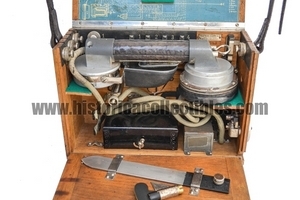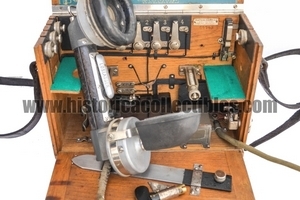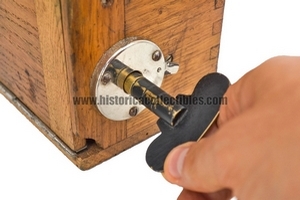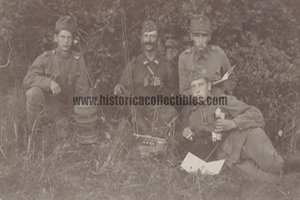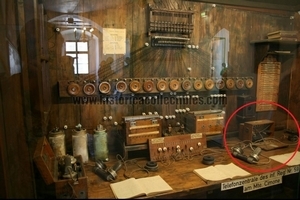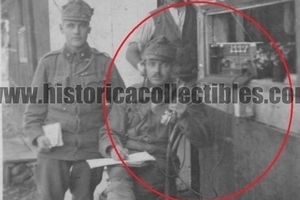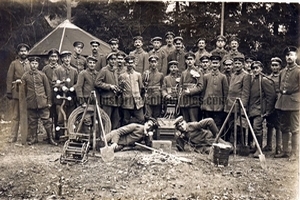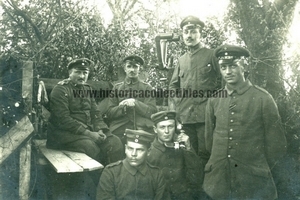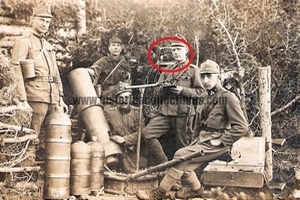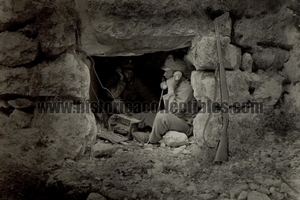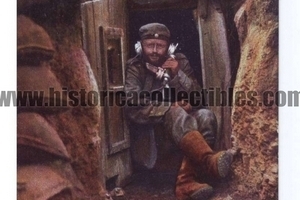Feldtelefon or Austrian Telephone mod. 09, Telephon Fabrik A.G., K.u.K., 1915
Feldtelefon or Austrian field telephone Mod. 09, produced in 1915, by "Telephon Fabrik A.G." - "vorm. j. Berliner" "WIEN, XIII/2 Missindorfstr. 21". On the cover, which houses the induction coil inside, in addition to the J. Berliner logo, the year "1915" is shown. This version is equipped with a selector device that can be activated using a special original key housed in the cover. Inside the lid you can see the writing "Aufruf" (followed by the relative Morse translation -..-) which means "Call". Telephone equipment supplied to the Austrian Army used throughout the First World War.
Excellent storage conditions: complete with its original shoulder strap.
Telephon Fabrik A.G." - "vorm. j. Berliner" "WIEN, XIII/2 Missindorfstr. 21" was founded by Emile Berliner, the man who perfected the Bell telephone and made it a marketable proposition. Berliner saw the Bell telephone in operation and decided to refine it and make it a better and more perfected instrument. He succeeded. and filed his patent on June 4, 1877. It was a "free contact" transmitter. He also invented an "Induction Coil" to be inserted into the circuit to prevent "interruptions" during the call when the contacts separated. Bell came to knowledge of Berliner's patent and purchased the rights to the transmitter for an astronomical sum of $50,000. Bell also asked Berliner to refine their instrument and resolve the problems he encountered.
Thomas Edison filed a patent for a similar improved transmitter, also thanks to "coal dust" it allowed more contacts than Berliner's which only provided one. The two patents were deemed "in conflict" by the Patent Office."
Meanwhile, the American Bell had been offered a new single transmitter by Francis Blake. This had been patented by Blake, and Bell decided to use it.
The directors of American Bell decided to delay the application of Berliner's patent to their equipment.
They informed the Patent Office that they needed to take time before responding to their requests.
Their goal was to sustain the patent long enough so that when the patent expired, Blake could activate the Berliner patent and maintain control of the telephone for another seventeen years. Following the resolution of the legal battle with the American Telephone Company, Edison's patent holder, American Bell, controlled all of the important telephony patents. Berliner was frustrated by the inactivity of his first major invention and left the company.
Even though he was now an American citizen, Berliner maintained contact with his family in Germany. In 1883 he demonstrated his single-contact transmitter in Austria. His interest was so strong that he founded a company, the "J. Berliner Telephone Factory (Telephon-Fabrik Berliner AG) in Hanover, Germany, which was managed by his brother Jacob.
The other brother, Joseph, was called back to Germany to become the factory's technical director: he had spent several years studying the telephone in the Bell laboratories and had thus become a competent technician and designer. Jacob became the company's sales manager because he was the only one who had experience running a business.
There were international patent recognitions in place in those years: manufacturers such as Siemens and Halske in Germany and Ericssons in Sweden had managed to copy and improve Bell's inventions, without patent problems. The Berliner company began producing telephones that conflicted with the Bell company's patents.
In 1893 Emile Berliner patented a transmitter very similar to Edison's model.
The German Post Office supported the local producers of this new industry. The company was able to supply parts and complete phones and set up factories and agencies in Vienna, Budapest, London and Paris. They had to be careful not to sell into the countries where Bell's patents were granted. They had to mark their equipment with the words "Use Not Licensed Under Any U.S. Patents".
The company was renamed Bayerische Telephon-Fabrik AG (BTA) in 1918 or 1920. At that time it was starting to experience financial difficulties. After the First World War the German market was limited due to the developing depression and the post-war punitive measures, and only companies with foreign participation were able to move forward successfully. By 1930 about 72% of the market was controlled by Siemens and Halske, and most of the rest by Elektrizitatgesellschaft (owned by ITT). In 1931 the company was renamed Tefag (Telefono Aktiengesellschaft vorm. J. Berliner).

